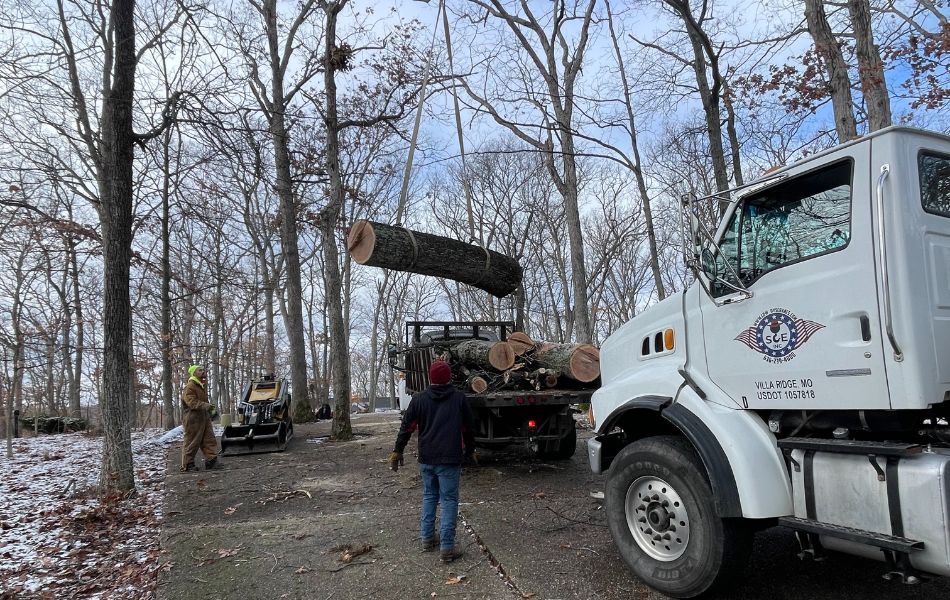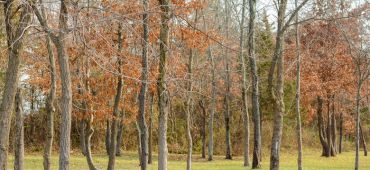6 Signs of When to Remove a Tree in Missouri

Is your tree a danger waiting to happen? Discover how to spot the warning signs and determine when to remove a tree to protect your St. Louis property.
Are you worried about a tree in your yard? Maybe it’s leaning after a storm, or its branches look brittle and lifeless. Knowing when to remove a tree is important for keeping your property and family safe. Ignoring the signs can turn a small problem into a big emergency. Don’t let a failing tree catch you off guard—here’s how to recognize the signs before it’s too late.
PRO TIP: A tree demonstrating any of these signs does not necessarily require removal. Speak with an arborist before making plans to remove a tree, and allow them to provide a recommendation. In some instances, they may be able to save a tree instead of removing it.
Key Takeaways
- Trees that grow too close to structures or utility lines will likely require removal to prevent damage.
- Any tree that leans more than 10-15 percent from vertical is at greater risk of uprooting.
- Insects and diseases can kill trees and leave them unstable.
- Storms may damage large portions of the tree and leave it unable to recover, necessitating removal.
- When something damages too much of a tree’s root system, it may become unstable and unable to get the necessary nutrients.
6 Signs to Look for to Know When to Remove a Tree
It’s not always obvious when you need to have a professional remove a tree. A tree may appear fine at a glance but have serious issues bubbling under the surface. Tree care companies will do what they can to try and save trees, but sometimes, there is no choice but to remove them.
PRO TIP: The urban trees of St. Louis face numerous threats from human activity and the natural environment. Planting the right tree in the right place can alleviate some of these concerns. For more information, see the Missouri Department of Conservation’s guide to caring for urban trees.

1. The Tree Is Too Close to Structures, Utility Lines, or Other Trees
One of the most common instances of tree removal in the greater St. Louis area is when they grow too close to buildings, structures, or utility lines. That’s because the tree puts your home or other structures at risk. Falling branches or a tree uprooting during a storm can instantly lead to an expensive repair bill. Proactively removing these trees will protect you from damage.
Some homeowners may accidentally plant multiple trees too close together. As these trees grow, they will compete for space and resources, and neither of their root systems will fully expand. Removing one of these trees will allow you to have one healthy tree rather than two struggling trees.
PRO TIP: You can prevent most instances of trees interfering with structures by planting the right tree in the right place. It can be difficult to judge the size of a fully grown tree when it’s just a sapling. Consult an arborist before planting a tree to ensure you have the proper space.
2. The Tree is Leaning
In ideal circumstances, a tree should grow straight up from the ground. When a tree develops a lean, however, it is a cause for concern. Leaning trees are more likely to uproot during a storm. Trees may begin to lean due to root issues or problems in the soil.
While a tree may develop a natural lean, anything greater than 10-15 percent from vertical can be hazardous. Have an arborist examine your tree and determine if the leaning puts your property at risk.
3. The Tree Is Under Attack from Insects or Diseases
Whether it’s oak trees dealing with the deadly oak wilt or ash trees fighting to survive against emerald ash borer, tree diseases and insects are an unfortunate reality in St. Charles and St. Louis counties. These problems can quickly kill a tree and make it a hazard to your property.
Some symptoms to watch for that might indicate an insect or disease problem with your tree include:
- Increased insect activity
- Discolored leaves or early fall colors
- Dead patches on the canopy
- Premature leaf drop
- Damaged bark

4. A Storm Damaged Tree Is Beyond Repair
Residents of St. Louis and St. Charles counties know all about the extreme weather we face. From summer storms, to tornadoes, and snowstorms, our trees have to stand up to the elements year-round.
Storms and tornadoes can kill trees or leave them too damaged to survive. After a storm, it’s best to have an arborist examine the damage. Generally speaking, a tree with more than 25 percent of its branches damaged will be at risk of not being able to fully recover.
5. The Tree Shows Substantial Root Damage
Roots deliver nutrients and water to the upper portions of a tree. They also help anchor a tree into the ground and allow it to stand upright. Roots can end up damaged in numerous ways, including:
- Lawn mowers
- Construction
- String trimmers
- Animal activity
- Insect activity
- Tree diseases
- Drought
Depending on how much of a tree’s root system is damaged, an arborist may be able to save it. However, if a tree has too many dead roots, the only thing to do is remove the tree.
6. The Tree Species Is Not Worth Keeping
Sometimes, it’s beneficial to remove a healthy tree when it is unwanted and not a desirable species in the St. Louis area. Invasive species can choke out our natural ecosystem and limit growth from native plants.
Not sure if you have an invasive tree on your property? Have an arborist identify it and provide a recommendation on whether removal is the right choice.
Frequently Asked Questions About Tree Removal
Is it possible to save my struggling tree?
Yes, it may be possible to save a struggling tree in some cases. It is best to let an arborist determine if it is viable to save your tree, as they have the expertise to diagnose what’s wrong and recommend the next step.
Can I keep a dead tree in my yard?
Yes, you can keep dead trees in your yard if it poses no risk to life or property. Dead trees provide a habitat for local wildlife, like birds. However, removal is the best option in smaller yards to protect yourself from the tree falling during a storm.
Can I remove a tree myself?
No, in most situations, tree removal isn’t something you can do yourself. While you may be able to remove a small tree on your own with the right equipment, trying to remove a larger tree can lead to serious injury or death.
What is the best time of year to remove a tree?
The best time to remove a tree is in winter, though there is no bad time to remove a tree, especially one that puts your property in danger.

Mathias Precision Can Help Safely Remove Your Trees
If you notice any signs demonstrating that removing a tree might be your best option, there isn’t time to waste. Trees can quickly become a risk to your property and family if you don’t do something about it. But even if you know when to remove a tree, you likely won’t know how or have the resources to complete the task.
Our team has the experience and equipment to determine the health of a tree, make recommendations, and then remove the tree, if necessary. We employ multiple ISA Certified Arborists who lend their expertise to every job we take. Call us today at 314-322-7690 or request an estimate online.




